#Agri-Drones
Explore tagged Tumblr posts
Text
Empowering Indian Agriculture: Unleashing the Potential of Agricultural UAVs
The agricultural sector in India is undergoing a remarkable transformation, fueled by the integration of drone technology. With the agricultural drone market projected to surge from $1.2 billion in 2019 to an impressive $4.8 billion by 2024, the shift towards precision agriculture is evident. Drones play a pivotal role in enhancing agronomic decision-making, offering real-time data for crop management. From government support to on-field success stories, the adoption of agricultural UAVs brings diverse advantages to Indian farmers, promising improved efficiency, reduced costs, and enhanced overall yields. As drones redefine the agrarian landscape, their impact is a testament to the evolving face of modern farming in India. For more details, checkout- https://www.indowings.com/
0 notes
Text
Rice Thrasher Complete
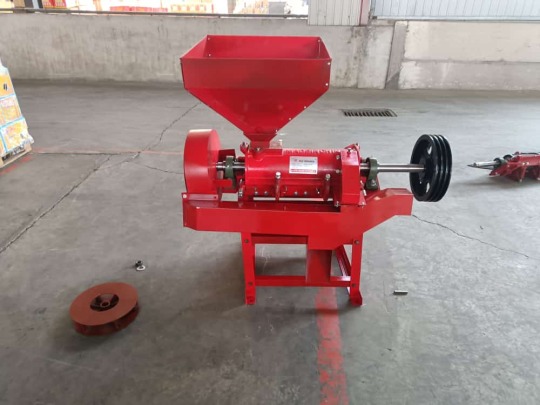
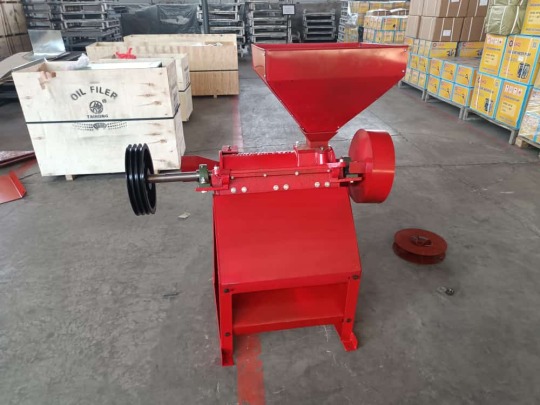
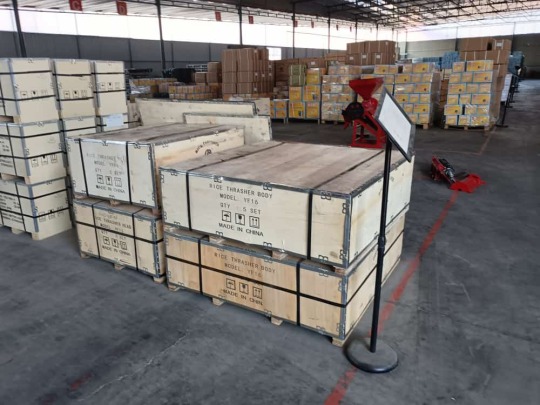
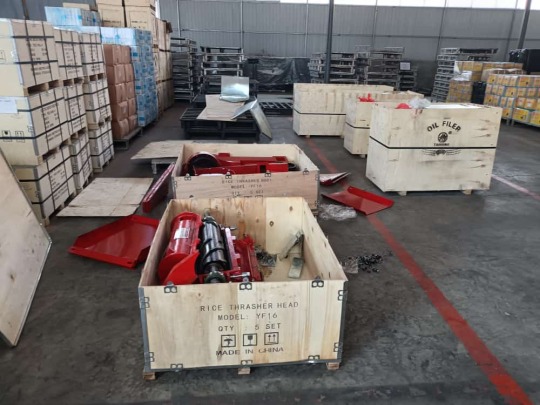

#agrotech#agricoltura#agribusiness#agriculture#agri drones south africa#agriturismo#agro processing#agroecologia#agrolife#agropoli#roxana agriche#dion agriche#reproductive rights
3 notes
·
View notes
Text

🌱🚀Agri-Tech is revolutionizing farming with cutting-edge solutions! From smart sensors and drones to AI-driven weather predictions, technology is making agriculture more efficient and sustainable. These advancements help us grow food more effectively while caring for our planet. Let’s support the tech that’s shaping a brighter, greener future for farming. 🌍🌿
0 notes
Text
The Next Era of Farming: How Drones Are Redefining Crop Management
In recent years, drone technology has emerged as one of the most transformative innovations in the agricultural industry. Originally used for aerial photography and surveillance, drones have quickly evolved into sophisticated tools that are now essential for modern farming practices. These unmanned aerial vehicles (UAVs) bring unprecedented levels of precision and efficiency to a variety of agricultural tasks, from crop monitoring and mapping to pesticide spraying and irrigation management. By providing real-time data and the ability to reach areas that are difficult or impossible to access with traditional equipment, drones are helping farmers optimize their operations, reduce costs, and make more informed decisions.
A prime example of this advanced technology is the VAANVILI AG10, a UAV expertly crafted for precision agriculture pesticide spraying. The VAANVILI AG10 represents the pinnacle of drone innovation, combining cutting-edge materials and advanced sensors to deliver exceptional performance in the field. Constructed from high-strength carbon fiber and aviation-grade aluminum, this drone is both lightweight and incredibly durable, able to withstand the demanding conditions of agricultural environments.
But what truly sets the VAANVILI AG10 apart is its integration of the latest generation of sensors and processors, which enable it to perform its tasks with unparalleled accuracy. Whether you're spraying pesticides, applying fertilizers, or conducting crop surveys, the VAANVILI AG10 ensures that every action is carried out with precision, reducing waste and optimizing the use of resources.

Vaanvili - The Future of Farming
1 note
·
View note
Text
Navigating Opportunities in the Agricultural Drone Market

According to the study by Next Move Strategy Consulting, the global Agricultural Drone Market size is predicted to reach USD 14.23 billion with a CAGR of 20.3% by 2030.
The agricultural sector, vital for sustenance and economic stability, is undergoing a transformation fueled by technological advancements. Among these innovations, drones have emerged as a pivotal tool in modern farming practices. With their ability to capture high-resolution imagery, collect data, and provide actionable insights, drones are revolutionizing the way farmers manage their fields.
Unlocking the Potential:
Agricultural drones offer unparalleled advantages in terms of precision, efficiency, and data-driven decision-making. Equipped with a variety of sensors and imaging technologies, these unmanned aerial vehicles can capture detailed information about crop health, soil conditions, and environmental factors. By analyzing this data, farmers can make informed decisions regarding irrigation, fertilization, pest control, and crop rotation, leading to optimized yields and reduced resource wastage.
Precision Farming:
One of the most significant applications of agricultural drones is in precision farming. By flying over fields and capturing high-resolution imagery, drones provide farmers with valuable insights into the health and condition of their crops. Advanced analytics software can then process this data to identify areas of concern such as pest infestations, nutrient deficiencies, or water stress. Armed with this information, farmers can implement targeted interventions, such as precision spraying or soil amendments, to address these issues efficiently and effectively.
Enhancing Crop Management:
Throughout the growing season, agricultural drones play a vital role in monitoring and managing crops. From planting to harvest, drones offer real-time visibility into crop development, enabling farmers to detect problems early and take proactive measures. For example, drones equipped with thermal imaging sensors can identify areas of poor drainage or irrigation inefficiency, allowing farmers to adjust their watering practices accordingly. Similarly, drones can monitor crop maturity and health, helping farmers optimize harvest timing and maximize yields.
Overcoming Challenges:
Despite their numerous benefits, agricultural drones face several challenges that hinder their widespread adoption. Regulatory issues, including airspace management and privacy concerns, pose significant barriers to drone deployment. Additionally, the upfront costs associated with drone technology, along with concerns about data security and reliability, may deter some farmers from investing in this technology. However, as regulatory frameworks evolve and technology becomes more accessible and affordable, these challenges are expected to diminish over time.
Future Outlook:
The future of the agricultural drone market is bright, driven by ongoing advancements in drone technology and increasing awareness of its benefits among farmers. As drones become more affordable, user-friendly, and capable, their adoption is likely to accelerate across a wide range of agricultural operations. Moreover, with the growing emphasis on sustainability and food security, drones can play a crucial role in optimizing agricultural practices to meet the demands of a rapidly expanding global population. By embracing drone technology, farmers can not only improve their productivity and profitability but also contribute to a more sustainable and resilient food system.
Remote Sensing and Data Analytics: Agricultural drones, equipped with advanced sensors and imaging technologies, enable remote sensing and data collection on a scale previously unimaginable. The data collected can be analyzed using sophisticated analytics software to generate actionable insights, aiding farmers in making informed decisions about crop management and resource allocation.
Precision Application of Inputs: By precisely targeting interventions such as fertilizers, pesticides, and water, agricultural drones help minimize input wastage and environmental impact. Through the precise application of inputs based on real-time data, farmers can optimize crop yields while reducing their reliance on chemicals and minimizing runoff into waterways.
Climate Resilience: Climate change poses significant challenges to agriculture, including unpredictable weather patterns, extreme temperatures, and shifting pest and disease pressures. Agricultural drones offer a means of monitoring and adapting to these challenges by providing timely information about crop health, soil moisture levels, and weather conditions. This enables farmers to implement adaptive strategies to mitigate the impacts of climate change and maintain productivity in the face of adversity.
Integration with Other Technologies: Agricultural drones are increasingly being integrated with other emerging technologies such as artificial intelligence (AI), Internet of Things (IoT), and blockchain to further enhance their capabilities. For example, AI-powered algorithms can analyze drone-captured imagery to detect subtle changes in crop health, while IoT sensors can provide real-time data on environmental conditions. Blockchain technology can facilitate secure data sharing and traceability throughout the agricultural supply chain, enhancing transparency and trust among stakeholders.
Inquire before buying, here: https://www.nextmsc.com/agricultural-drone-market/inquire-before-buying
Support for Smallholder Farmers: While large-scale commercial farms stand to benefit significantly from agricultural drone technology, its potential impact on smallholder farmers in developing countries is equally profound. By providing access to affordable drone technology and training programs, organizations and governments can empower smallholder farmers to improve their productivity, resilience, and livelihoods. Drones can enable these farmers to overcome challenges such as limited access to resources, poor infrastructure, and climate-related risks, ultimately contributing to poverty alleviation and food security.
Regulatory Harmonization and Standardization: To realize the full potential of agricultural drones, it is essential to establish harmonized regulatory frameworks and industry standards that promote safety, interoperability, and innovation. Governments and regulatory agencies must collaborate with industry stakeholders to develop clear guidelines for drone operations, airspace management, data privacy, and liability. Standardization efforts can facilitate interoperability among different drone platforms and ensure compatibility with existing agricultural machinery and systems, thereby fostering greater adoption and integration of drone technology into mainstream farming practices.
Conclusion:
In conclusion, the agricultural drone market presents vast opportunities for innovation and growth. By harnessing the power of drone technology, farmers can gain valuable insights into their crops, optimize resource allocation, and increase yields while minimizing environmental impact.
With the projected growth, it's evident that the agricultural drone market is poised for significant expansion in the coming years. As drones continue to navigate new horizons and revolutionize the way we farm, stakeholders across the agricultural industry must embrace this technology to stay competitive and sustainable in an increasingly complex and interconnected world.
0 notes
Text
https://harisharandevgan.com/new-technology-in-agriculture-2023/
The adaptation of new technology in agriculture 2023 is a testament to his wisdom that inspires us to adopt the remarkable changes coming
#technology in agriculture#ag tech#ag technologies#farming technology#agriculture tech#agriculture and technology#agri technology#agric technology#technology and farming#tech agri#precision agriculture#drones in agriculture
1 note
·
View note
Video
youtube
सुधारित कृषि #तंत्रज्ञानाची जागरूकता आणि #कृषि #ड्रोनचे #प्रात्यक्षिक #a...
1 note
·
View note
Text
Best Agricultural Drone Companies in India

My Krishiviman is the Best Agricultural Drone Companies in India. First UAV Drone are the best option for the farmers of India.By deploying indigenously developed automated, AI based agriculture systems to make agriculture more efficient, sustainable and profitable.We have expanded our capabilities to Drone based surveillance and mapping, spraying , thermal imaging and precision agriculture practices. sanitization, agriculture spraying, mapping, delivery, and surveillance.We are DGCA approved Drone Pilot Training organisation, providing world class training in Drone Flying .To empower farming communities and Rural Youth with Latest and Sustainable Technology solution to foster financial growth of Agriculture based rural economy.
#Agricultural Drone Companies in India#First UAV Drone#Agricultural drones#agri drone#drone manufacturing company in India
1 note
·
View note
Text
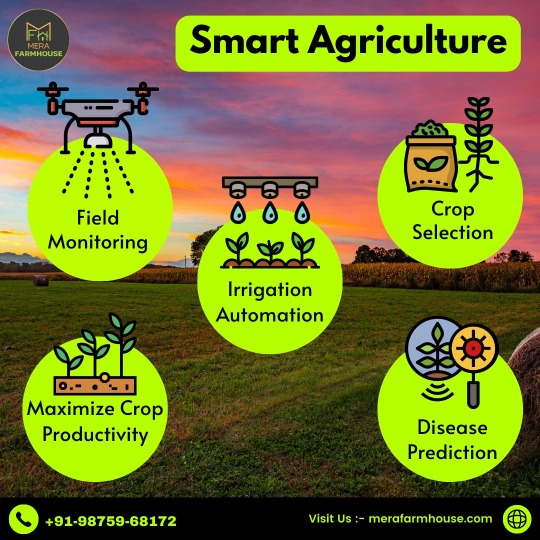
Smart agriculture is a farming management approach that uses technology to optimize crop yields, reduce waste and improve overall efficiency. It plays a key role in helping address the growing need for efficient food production practices with the growing global population.
farmers👨🌾 are becoming #Smartfarmers
🔑 Key Benefits of IoT (Smart Farming) in Agriculture & Smart Farming
Soil Management
Water💦 Management with Automatic irrigation
Monitoring of 🐄 livestock & climate conditions
Precision Farming
Drones
Farm🌱 Management Systems
Greenhouse automation
Crop 🌾 monitoring
💚🌻💚🌼💚🌺💚🌸💚🏵️💚 ❤️Stay Connected 📱 Call or WhatsApp: 🚜🌾 📱 https://wa.link/lsblym Call 📞 09875968172 🌐: www.merafarmhouse.com 🚜 𝐌𝐞𝐫𝐚 𝐅𝐚𝐫𝐦𝐡𝐨𝐮𝐬𝐞 🚶 ♀️ 𝟑𝟕𝟗, 𝐈𝐧𝐝𝐮𝐬𝐭𝐫𝐢𝐚𝐥 𝐀𝐫𝐞𝐚 𝐏𝐡𝐚𝐬𝐞 𝐈𝐈, 𝐂𝐡𝐚𝐧𝐝𝐢𝐠𝐚𝐫𝐡, 𝟏𝟔𝟎𝟎𝟎𝟐
🌐If you like the post then follow the page. 🌐 🔹🅵🅾🅻🅻🅾🆆 🆄🆂 🅰🆃 👇 Facebook: https://www.facebook.com/merafarmhousedotcom Instagram: https://www.instagram.com/merafarmhouse
#agtech#ag#agri#agritech#irrigation#irrigationautomation#smartfarming#PrecisionFarming#livestockmanagement#soilmanagement#drones#smartagriculture#agriculturetechnology#mfh#merafarmhouse#farmingandagriculture#besttipsonfarming#typesoffarming#agriculture#subsistencesfarming#commericalfarming
0 notes
Text
Drone Manufacturing Companies in India
Magic Myna is firmly committed and well placed to spearhead Commercialisation of multi-copter drones for Societal Applications in India and beyond through inhouse and collaborative approach , the most recent being the formal know how transfer agreements signed with CSIR-NAL on the sidelines of Wings India 2022 at Hyderabad.
For more news follow our website - https://www.magicmyna.in/
0 notes
Text
All the way from Rajkot India, Mr. PINTO visit us in Kano State, Nigeria. One of our great Manufacturers and Suppliers of Agricultural Machineries and Spare Parts.









#india#rajkot#jschlatt jambo#agribusiness#agri drones south africa#agricoltura#agriculture#agro processing#agrolife#agrotech#agroecologia#agriturismo#agropoli
0 notes
Text


Safety First! Please Care For Every Pre-flight Inspection.
Avoiding safety risks is essential to prevent unnecessary losses. ⚡
Here are some key takeaways—ensure you've covered them and enhance your expertise with our professional guides.
Learn more:https://www.effort-tech.com/en/home
#agricultural drone#drone tech#EFT drone#drone sprayer#spraying drone#agri drone#drone operayion#drone safety#safety tips#operation safety#flight care#pre-flight precaution#Z30P#Z50P
0 notes
Text
No Father but the Machines
Describe a characters life in five sentences and ten minutes. Do this five times, and explore the character differently each time.
He was a farmer who had seen the horse-drawn plow as a boy and the automated multi-lane smart-harvester as an aging man. He had plowed the fields under scorching sun with calloused hands at age sixteen, and piloted the silent machine with the neurocaster from the comfort of his couch at age sixty. When he was a boy the seeds were bought from a friend of his father’s who rolled through the countryside on a wagon. When he was a young man and his father was freshly underneath the apricot tree he had found the gene-tweaked seeds pushing through his soil and felt the long heavy shadow of the agri-corps. When he was young his father owned his farm and sold his crops at market, and when he was old the pale trucks would roll up to collect his harvest and tell him the debt was nearly paid.
The automated fields are unsafe for play. When he was a child he used to dive into a world of swaying, breathing gold-green strands and disappear for hours. At hoe-down festivals they would carve mazes out of the harvested stalks and eat and dance. Then as he grew, the fields seemed to shrink, boundless rippling gold seas becoming a brown swath of income. How he wished to go in there once again, for the agri-corp barley was five times as tall as when he was a boy, and ten times as bloated. He would be a child again in his world of green-gold, with no father but the machines.
The first storm had come when he was seventeen. He was used to hurricanes, but these storms were unnatural, manmade, burning with the fury of mother nature. The storm lasted weeks as it rolled along. When he was thirty, the climate-drones hung overhead in the blue, but the weather came regardless of their efforts and they were thrown to the ground like raindrops and torn apart in the maelstrom. When he was fifty, deluges were a fact of life, and all the houses were equipped with rafts. When he was seventy, he heard they were calling it the Mississippian Sea.
When he was eighteen he had wanted to be a pilot. His father had laughed and told him that real pilots used to be in the aircraft, which sounded as dangerous as it was ridiculous. When he was nineteen the warships glided overhead like wasps from a kicked nest, and he ran from home to join. When he was twenty he had seen seas and villages and cities, all of them burning, and the neurologist said it was prolonged exposure to experimental neurological connections that had made him send his ship straight into the sea. He returned to the farm where the great network towers split the sunset he’d watched as a child and his father was being inexorably killed by his own lungs.
He'd once had a partner who kept him company out in the farm, in his forties. His kids couldn’t play in the fields, but they loved to watch him pilot the machines. They asked him if they could play with the robots, but he had to tell them no, they weren’t his but the company’s. He remembered riding the temperamental horse Tugboat as his father guided them along, plowing the fields, and wished his children could have the same. He remembered how the corporation had refused liability for the death, citing the contract they had signed, and how after all his son should not have been in the automated field to begin with. At seventy, he looked out to the apricot tree, where the people he loved slept in the soil that the company owned and the machines plowed.
3 notes
·
View notes
Text
System Collapse, Chapter 1
(Curious what I'm doing here? Read this post! For the link index and a primer on The Murderbot Diaries, read this one! Like what you see? Send me a Ko-Fi.)
In which we're back on the forward-track of the timeline.
Dr. Bharadwaj once told Murderbot that she thought it hated planets because it feared being judged expendable and left behind on one. MB lied to her, and said it's because planets are boring. Well, planets aren't boring, but it's less-boring in a bad way. Especially when you're investigating pre-Rim possibly alien contaminated sites in an environmental suit because you were being weird about wearing your armour.
MB decides to back up the conversation a bit for context.(1)
About 47 hours before our story starts, MB wanted to punch something in the face, preferably Art, or itself. They were already on the alien-contaminated planet. MB was surveilling a building. Having chased Ratthi,(2) Iris, and Tarik into the building, Hostile One, an agri-bot like the ones MB found scary in Network Effect, couldn't fit to follow.(3)
Art is asking for a status report, and MB waves it off, but it wants MB's personal status, not mission status.
Ugh, my status. I wasn’t supposed to come down to the planet again. Me, ART, Mensah, Seth, and Martyn had all made that decision, because of redacted.(4) I had even had an assignment during this day-cycle, sort of. It wasn’t really busywork, but it wasn’t not busywork, either. Karime had an in-person meeting planned with a faction of colonists at the main site habitation, and Three was going with her for security while pretending to be a human (always a fun time) and I was supposed to monitor Three and make sure it knew what to do and to not let ART give it anxiety. (Or more anxiety than it already had on its own.) I had been lying on the bunk in one of ART’s cabins watching The Rise and Fall of Sanctuary Moon (episode 121, on repeat) while waiting for Karime and Three’s shuttle to arrive at the meeting site, when ART had slammed into my feed and said, I need you.(5)
Art couldn't use a pathfinder to take out the agribot, because that explosion would hurt the humans, so it became MB's turn.
On the feed, Ratthi asks how MB is doing. MB says it's fine, but not to let anyone get closer to the ag-bot's tentacle. Ratthi says it's a growth stimulator,(6) and it's fine, there's no rush.
You’re not fine, Ratthi, for fuck’s sake. (For however many corporate standard years, all I got from humans was “Run in there now no matter how likely you are to get blown to tiny pieces when a quiet tactical approach has a higher percentage of success” and now it’s “Oh no we’re fine, we can hang out in this objectively terrifying immediately hazardous situation for however long.”)(7)
MB continues to grumble in its thoughts about humans' penchant for understating things, and how Bharadwaj says even good changes can be stressful. While it does, its drones keep scouting for a position to take a good shot at the ag-bot with the recall beacon Art decided to repurpose to take it out. MB is glad for a weapon that won't bring it close enough to get its ass handed to it, again, by one of them.
A paragraph is spent comparing this ag-bot to the ones in Network Effect, and how similar and different the alien contamination was. Another paragraph is used to show Seth explaining the recall beacon, and apologizing to MB for having to go on-planet despite whatever the earlier redacted portion was. MB told him it was fine, and reiterates to the reader that it's fine, just fine, dangit.(8)
At any rate, a drone finds a good vantage point, but something about the threat assessment number, as well as the likelihood of successful retrieval, gives MB pause. As it reviews the numbers and the situation, it realizes it's not going to work. This is the problem with letting Art and the humans come up with the plans, really, and MB would have been more proactive about it, but the redacted incident.(9)
MB is on the move again, and sends its calculations to Art in place of an explanation. It would love to have Three here, but that would mean interrupting Karime's meeting, which is very important. And, there's no reason MB can't handle this. It already has a new plan, even! And threat assessment likes it more, because the explosion is further from the humans.
MB drops two transponders then gets the ag-bot's attention. It gives chase, and as it approaches the first, MB signals to detonate it… but the ag-bot jumps, as the contamination must have increased its processing and access to local networks.
As it's about to land on MB, two things happen: first, MB rolls to point the launcher for the last recall transponder up at it, and second, MB receives a ping from another SecUnit. At first it assumes it's Three, somehow, which would be embarrassing but also a relief. Only, it literally can't be Three, there wasn't time for it to get here, which means… it's a Barish-Estranza SecUnit.
Four days after Preservation showed up in Network Effect, a B-E explorer had arrived with three fresh SecUnits, minimum. The B-E group has been more proactive about evaluating the situation and talking to the colonists. Art ran the numbers, more than once, and it wasn't worth just killing them all on principle.
The other SecUnit hits the ag-bot with projectiles, right in the central processor as well as some shots to break it up, as it falls toward MB. MB, for its part, is able to roll out of the way of the debris. Art says that was too close to a murder attempt.
MB has everyone lock down for security, since it knows what a SecUnit is capable of intercepting, and runs all its new and improved human movement code. It asks if they can call off their SecUnit, and tries to groan and rise like a human would have in its situation. It even makes the effort to look at what it now terms B-E Unit1, and as Ratthi runs up to check on it, it asks him to pretend to help it up.
Ratthi, thankfully, picks up the situation immediately, and tells the B-E party that was too close. MB thinks about what it would have done differently, or at least tried to do.
(Obviously this is not actually what I’m upset about, it’s just easier to be angry about B-E Unit1’s fuckup and/or disregard for minimum client safety.) Safer to be angry about it, ART said on our private connection. I was not even going to respond to that. ART had told Mensah it wouldn’t push me. Just because its MedSystem was certified for emotional support and trauma recovery it thought it knew everything.(10)
Iris goes to meet the B-E leader, with Tarik close by and wearing his visor the way MB is, so it doesn't look out of place for covering its face. The leader is someone they've seen before, Sub-Supervisor Dellcourt, who is one of the smart ones. Iris thanks them too-politely,(11) and asks if they'll be billing later. Dellcourt says they'll add it to the creditor's statement.
MB explains how the billing is not a joke, Pin-Lee and Turi, Art's accountant, have been preparing a counter-bill if this ever ends. Money fights between corps are common and boring.
If you wonder why Art has an accountant, Martyn said Art is perfectly capable of doing its own accounting, but ends up with extra numbers that not even their best accountants can track. Turi does it with hardcopy backup ledgers, to make sure Art can't edit the data. There's a question about whether Art is making up numbers for fun, or if it has credit balances somewhere they don't know about.
Back to the story, where Dellcourt asks what business they have here. Iris asks the same. MB thinks it's some human posturing thing it doesn't understand, but it's pretty obvious Iris's group has been repairing the routers, and given the projectiles Unit1 had, the B-Es were looking for contaminated bots.
MB takes another aside(12) to describe the first interaction between the fresh B-E explorer and Art, which ended with B-E scuttling off and probably believing Art is an asshole human commanding officer. It clarifies that Art's sapience is a secret from everyone except the ranked levels of its university, and its team, and MB's team, so B-E have no way of even guessing what Art really is.
The rest of the B-E group is watching MB and the other humans. MB is glad it refined its human movement code, so it knows what to do with its hands. Still, it can tell Unit1 is staring at it. Iris, whether she noticed this as well or not, turns to thank Unit1. Dellcourt is dismissive, saying it's a SecUnit. Iris ignores him, and her team collect their equipment and leave.
=====
(1) Much appreciated, old friend. (2) Hey, I thought Murderbot was the only one sticking around for Art's missions! Nice to see another familiar face. And, Ratthi's really grown on me this reread. (3) Nice callback, not mentioning the book name (I did that myself) but making the connection for the reader. (4) Do you think we'll get an unredacted version of this in the book? Is it just referring to the events of Network Effect? (5) And, of course, what is MB going to do when its friend is in need? Help, that's what. (6) Oh that's what they're calling it these days? (7) Yep, sorry, people acknowledge your personhood now, and will be as polite to you as they would try to be to anyone else. (8) The more you say it, the less I believe it. Sorry. (9) Every repetition just makes me more curious. Why is this event redacted? (10) And to be fair, Art knows a lot. MB's just as stubborn as Mensah was about needing emotional help and support. (11) I very much imagine this in the vein of the "Bless your heart" of the southern US. (12) Every other paragraph in this opening chapter, I swear. To some degree I understand the necessity, since there's obviously been some time skip, and things need clarifying, but even so.
#the murderbot diaries#murderbot diaries#system collapse#murderbot#secunit#ratthi#tarik (murderbot)#iris (murderbot)#seth (murderbot)#martyn (murderbot)#art (murderbot)#dellcourt (murderbot)#three (murderbot)
6 notes
·
View notes
Text
HOW ARE DRONES CHANGING THE WORLD?
Technology continues to make ripples across the globe with groundbreaking discoveries and innovations to tackle simple business problems. Amongst the myriad of these technological advancements, drones are considered to be the most important addition as we step into the golden era of technology. Initially, drones were used as effective tools for surveillance during the war, thereby transforming how we witness the world and reshaping reality. Today, many major corporations are trying to adapt drones for delivery. The easy availability of lost-cost drones and the ability to effortlessly control these devices are the reasons for drones becoming more mainstream. The need for drones is evident and growing in every major sector, ranging from agriculture to healthcare.
0 notes